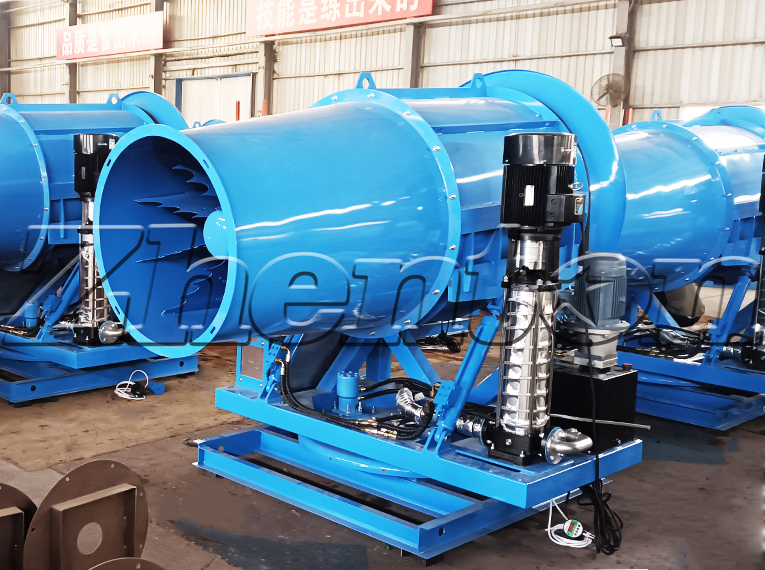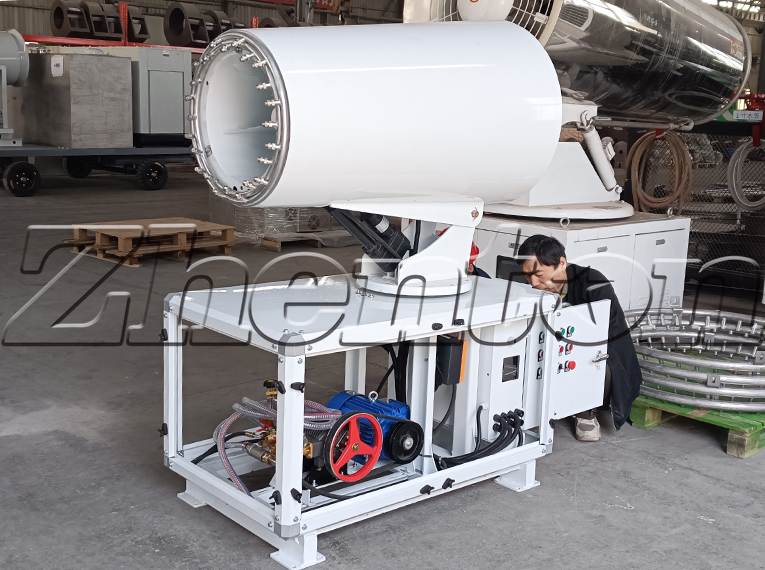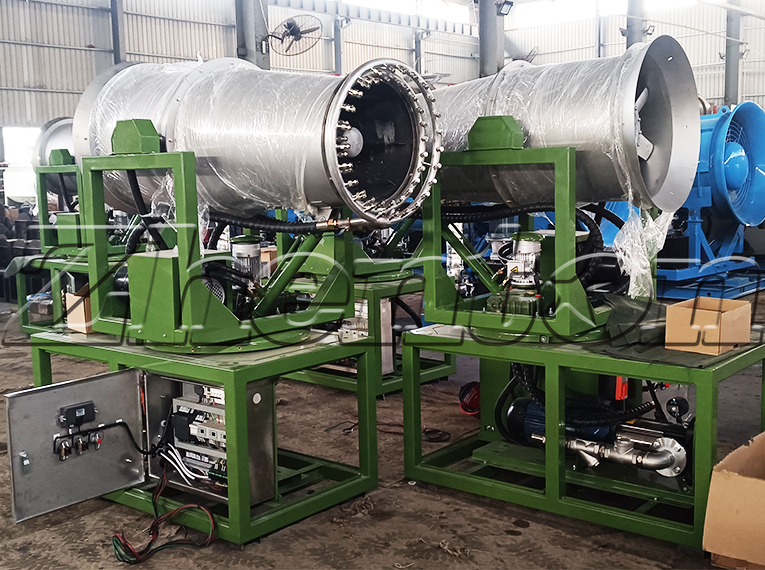In steel mills, between towering chimneys and scalding molten steel, an invisible "dust war" never ceases. Dust generated in processes like sintering, crushing, and transportation acts as a "stealth killer" in the air—not only shrouding the plant in a thick gray haze but also threatening workers' health with PM2.5, heavy metals, and other hazards. It even causes equipment failures and safety risks due to dust accumulation. Industry data shows that traditional dust control methods are less than 40% efficient in steel mills' complex environments. However, a device called the mist cannon machine is pioneering a new paradigm of clean production in steel mills with disruptive technology.
Steel Dust: The Gray Shadow of Industrial Civilization
Entering a steel mill's production area, dust clouds from crushers can rise tens of meters high, while yellow smoke-like dust billows from conveyor belts. These dust particles contain not only iron oxides but also heavy metals like lead and mercury. Workers exposed long-term have a pneumoconiosis prevalence 30 times higher than the general population. Meanwhile, dust accumulation on precision equipment parts like motors and bearings increases equipment failure rates by 25%, with annual maintenance costs from dust-related issues accounting for 18% of total steel mill maintenance expenses. More critically, as environmental standards tighten, steel mills face annual 15% increases in dust emission fines, making traditional methods like water trucks and bag dust collectors inadequate for modern pollution control needs.
Mist Cannon Machines: "Air Purifiers" in the Steel Jungle
Micron-Level Dust Suppression: A Precise "Air Fishing Net" for Dust
Mist cannon machines use high-pressure pumps to pressurize water to 8-12MPa, spraying 20-50 micron water droplets through specialized nozzles—this particle size closely matches major steel mill dust particles (10-100 microns), acting like a fine "water net" in the air. When droplets collide with dust particles, they bind via van der Waals forces, causing dust to settle naturally as it gains weight. In a sintering workshop test, PM10 concentrations dropped from 1,200μg/m³ to 150μg/m³ within 30 minutes of activating the mist cannon machine, achieving an 87.5% dust suppression efficiency—far exceeding traditional water trucks' 60% average.
Intelligent Air Delivery System: Making Water Mist "Go Against the Wind"
For steel mills' complex indoor airflow, new-generation mist cannon machines feature intelligent air delivery systems: high-power fans generate 12-level strong winds, pushing water mist 80-120 meters away, maintaining effective range even in 5-level headwinds. Near steel furnaces, 360° rotating turntables and ±45° pitch adjustment ensure precise coverage of dust sources like overhead bins and iron tapping points, eliminating "blind spots" of traditional fixed sprinklers. A coastal steel mill used mist cannon machines during typhoon season, still achieving unorganized dust emissions below 5mg/m³—meeting ultra-low emission standards.
Energy-Saving Black Technology: Tripling Dust Suppression per Ton of Water
Traditional water trucks consume 15 tons of water to suppress 1 ton of dust, while mist cannon machines triple this to 45 tons per ton of dust, thanks to "air-water mixed atomization" technology. Gas-liquid two-phase flow nozzles fully mix water with compressed air, expanding the atomized surface area by 1,000 times. The same water volume covers 5 times more area than traditional sprinklers. An 8-million-ton steel mill using mist cannon machines saved over 200,000 tons of water annually—equivalent to 140 standard swimming pools—while reducing dust suppression chemical use by 60%, achieving both environmental and economic benefits.

From "Dust Removal" to "Smart Control": The Future Evolution of Mist Cannon Machines
New-generation mist cannon machines are deeply integrated with IoT technology: dust monitoring sensors trigger automatic on/off based on PM2.5 thresholds, enabling "unattended" smart dust control. In a smart steel mill, managers monitor 20 mist cannon machines' status in real time via a central control screen, with the system optimizing spray angles based on wind direction and humidity—boosting overall efficiency by 12%. Some models even integrate solar power systems, achieving "zero electricity cost" dust suppression in open-air stockyards and further reducing green transformation costs.
Under the pressure of carbon neutrality goals, the green transformation of the steel industry has shifted from an "option" to a "must." Mist cannon machines, with their precision, efficiency, and intelligence, not only remove the "gray hat" from steel mills but also rebuild the balance between industrial production and the environment through technology. As micron-level water mist weaves a clean "air protection net" in the steel jungle, what we see is not just a numerical drop in dust concentration but a firm stride of traditional industry toward a green future.
How Fog Cannon Machines Are Revolutionizing Dust Control on Construction Sites
In the bustling world of construction, where steel and concrete shape the skyline, one persistent challenge has long plagued projects: dust pollution. From earthmoving to material handling, every phase of construction releases fine particles into the air, posing risks to worker health, delaying projects due to environmental violations, and staining the reputation of builders. Traditional methods like manual watering and dust nets often fall short, with studies showing they can only control dust in 50% of open construction areas. Enter fog cannon machines—the innovative solution that’s transforming how the industry tackles dust, merging efficiency with environmental responsibility.
The Hidden Costs of Construction Dust
Construction dust is more than just a nuisance. Composed of silica, heavy metals, and allergens, it creates a silent health crisis: workers exposed to dust are 40% more likely to develop respiratory diseases than the general population. Beyond health risks, dust-related complaints account for 65% of construction site 扰民 (noise and disturbance) reports, often leading to fines or project halts. With strict new regulations mandating PM10 levels below 80μg/m³ in many regions, builders face a stark choice: adapt or fall behind.
Fog Cannon Machines: The High-Tech Answer to a Persistent Problem
Precision Atomization: A Scientific Approach to Dust Suppression
Fog cannon machines use advanced high-pressure atomization technology to break water into 20–100 micron droplets—sized perfectly to bond with dust particles (10–200 microns). This creates heavier clusters that fall to the ground, rather than lingering in the air. In a recent case study at a metro construction site, fog cannons reduced PM10 levels from 500μg/m³ to 60μg/m³ in just 15 minutes, achieving an 88% dust suppression rate—far outperforming traditional water trucks.
Unmatched Reach and Flexibility
Designed for the sprawling nature of construction sites, fog cannons offer adjustable ranges from 30 to 120 meters, covering up to 20,000 square meters per unit. Their intelligent 360° rotating heads and vertical adjustment (-10° to +60°) ensure no corner is left uncovered, even in complex layouts like high-rise sites or deep excavations. For example, at a skyscraper project, fog cannons were programmed to track crane movements, targeting dust at its source—high in the air—where traditional methods fail.
Efficiency Meets Sustainability
Fog cannons aren’t just effective; they’re eco-friendly. Using a combination of air and water, they use 75% less water than traditional sprinklers, saving up to 100,000 tons of water annually on large sites. Some models even integrate solar panels, enabling off-grid operation and zero carbon emissions. For versatility, they can mix water with dust suppressants or disinfectants, serving dual roles in hygiene and pollution control—a major plus during pandemic-era safety protocols.
The Future of Dust Control: Smart, Connected, and Proactive
The next generation of fog cannons is the epitome of smart construction. Integrated with IoT sensors, these machines automatically adjust settings based on real-time dust data. When PM levels rise, they power on, swivel to the source, and deploy the optimal mist density—all without human intervention. Project managers can monitor performance via apps, receiving alerts and generating compliance reports at the touch of a button. In one smart city project, this system cut dust exceedance events by 70%, streamlining operations and reducing administrative burdens.
Why Forward-Thinking Builders Are Making the Switch
For construction companies, adopting fog cannons isn’t just about meeting regulations—it’s a strategic move. By prioritizing worker health, minimizing delays, and enhancing public perception, these machines pay for themselves in reduced downtime and improved productivity. As one site manager put it: “Fog cannons don’t just clean the air—they future-proof our projects.”

In an industry where progress and sustainability must coexist, fog cannon machines are the bridge to a cleaner, safer, and more efficient future. They prove that even in the midst of chaos, technology can create order—and a breath of fresh air.











